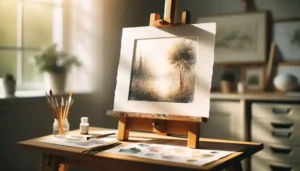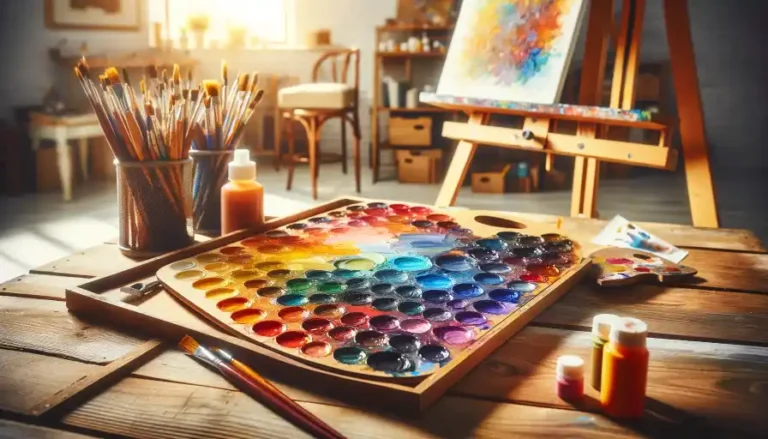Oil vs Acrylic vs Watercolor: Battle of Art Mediums
Oil painting, acrylic painting, and watercolor painting are among the most popular art mediums. Every medium offers different textures, colors, and techniques for artists to try.
In oil painting, artists mix pigments with oils to create a rich and vivid look.
Acrylic painting, however, uses water-based paints that dry quickly and can be used in many ways. Watercolor painting uses pigments in water to make soft and see-through layers of color.
Whether you are experienced or new to painting, knowing the differences between oil, acrylic, and watercolor helps you choose the right medium for your style.
Key Takeaways:
Support us by using our links. We may earn a commission, but it won’t cost you extra. Win-win shopping
- Oil painting, acrylic painting, and watercolor painting are popular art mediums with distinct properties and techniques.
- Oil paints offer a rich and vibrant finish, but they have a longer drying time and require additional supplies.
- Acrylic paints dry quickly and provide versatility, but they may be challenging to blend and have a different texture.
- Watercolor paints offer transparency and luminosity but require quick execution and careful paper selection.
- Choosing the right medium depends on your artistic preferences, desired effects, and techniques.
Oil vs Acrylic vs Watercolor
Pros and Cons of Oil Paint
Oil paints are favored by many artists because they are smooth and blendable. Let’s look at the advantages and disadvantages of oil paints compared to acrylics.

Advantages of Oil Paint:
- Smooth Texture: Oil paints are smooth like butter, which makes blending and layering colors easy, leading to attractive artwork textures.
- Bright Colors: Oil paints offer a range of bright and deep colors, allowing artists to create shiny, rich-looking pieces.
- More Time to Work: Oil paints dry slower than acrylics, giving artists extra time to blend colors and add details.
Disadvantages of Oil Paint:
- Slow Drying: The long drying time of oil paints can be a downside for those who prefer fast-drying mediums or have tight deadlines.
- Need for Extra Supplies: Extra items like solvents and thinners are needed with oil paints, making the process more complicated and costly.
Even with these drawbacks, the smoothness, bright colors, and extended working time are often worth it for artists. These qualities enable more artistic freedom and the creation of striking art.
| Pros | Cons | |
|---|---|---|
| Texture | Rich and smooth blending | N/A |
| Colors | Vibrant and saturated | N/A |
| Drying Time | Extended working time | Long drying time |
| Supplies | N/A | Additional supplies needed |
Now that we’ve explored the pros and cons of oil paint, let’s move on to the next section where we’ll discuss the advantages and disadvantages of acrylic paint.
Pros and Cons of Acrylic Paint
Acrylic paints are a favorite among artists because they dry quickly. Fast drying allows for rapid layering without the wait required for oil paints, which can take days.
Artists can work fast and spontaneously thanks to this quick setting time.
The versatility of acrylics is another benefit. They can be used on many surfaces such as canvas, paper, wood, and metal. This allows for a wide exploration of techniques and materials.
Furthermore, with a vast selection of mixable colors, artists can easily create custom shades, offering complete control over the color palette.
While there are many advantages, acrylics do have drawbacks.
The quick drying can be a challenge; it’s hard to blend colors or achieve smooth transitions as the paint sets quickly. Artists need to work fast to get the desired effects with acrylics.

Pros and Cons of Acrylic Paint:
| Pros | Cons |
|---|---|
| Fast drying time | Quick drying can make blending and transitions challenging |
| Versatility on various surfaces | Different texture and finish compared to oil paint |
| Wide range of colors and easy mixing |
Artists favor acrylic paint for its quick drying, its adaptability, and its vast selection of colors. However, it can pose challenges with blending and texture.
For those who prefer to create art quickly and spontaneously, acrylics may be the perfect choice.
Watercolor Painting
Watercolor is a special art form with both benefits and drawbacks. Knowing the good and bad points of watercolor can guide artists in using it well in their work.

Pros of Watercolor Painting
- Transparency and luminosity: Watercolor paints have a unique transparency that allows light to pass through the layers, resulting in a luminous and ethereal quality in the artwork.
- Vibrant washes of color: Watercolors offer the ability to create vibrant and delicate washes of color, making it ideal for capturing the spontaneity and freshness of a subject.
- Layering and blending: Watercolor paints can be easily layered and blended to create subtle variations in hue and value, allowing artists to achieve a wide range of effects and textures.
Cons of Watercolor Painting
- Quick drying time: Watercolor paints dry quickly, which can make it challenging to make corrections or changes once the paint has dried on the paper.
- Limited room for correction: Unlike oil or acrylic paints, watercolors do not allow for easy lifting or covering mistakes, requiring precise execution and careful planning.
- Paper selection: The choice of paper used for watercolor painting plays a significant role in the final result. Different types of paper absorb and interact with the paint differently, affecting how the colors appear on the surface.
In summary, watercolor painting stands out for its clear, bright, and lively color flows. Yet, artists must paint fast and with care, as watercolors dry quickly. The paper chosen also affects the artwork, needing thoughtful selection.
Even with these hurdles, watercolor lets artists capture their subjects in a lively and direct way.
Table: Comparison of Oil, Acrylic, and Watercolor Painting
| Medium | Pros | Cons |
|---|---|---|
| Oil Painting | Rich, lustrous finish Extended working time Ability to blend and layer colors | Long drying time Requires additional supplies Strong odor and fumes |
| Acrylic Painting | Fast drying time Versatile applications Water-soluble and easy cleanup | Dries quickly, challenging to blend colors Slight difference in texture and finish May require multiple layers for opacity |
| Watercolor Painting | Transparency and luminosity Vibrant washes of color Ability to layer and blend | Quick drying time Limited room for correction Paper selection impacts final result |
Choosing the Right Medium
Choosing oil or acrylic paint affects your artwork’s look and the painting process. Let’s look at how oil and acrylic paints differ to help you choose.
Comparison of Oil and Acrylic Paint
Table: oil vs acrylic paint
| Factors | Oil Paint | Acrylic Paint |
|---|---|---|
| Drying Time | Slow: Allows for more blending and working time | Fast: Dries quickly, suitable for quick techniques |
| Texture | Buttery and smooth | Can vary from fluid to heavy body |
| Color Vibrancy | Rich and vibrant colors | Wide range of colors with good vibrancy |
| Supplies | Requires additional supplies like solvents and mediums | Requires minimal additional supplies |
Oil paint dries slowly, giving artists more control over color blending. Its buttery texture leads to a smooth finish in paintings. Acrylic paint dries fast, which is great for artists who like to work quickly.
It also provides a wide color selection and works on many surfaces.
For supplies, oil paint needs extra materials like solvents and mediums for thinning and cleaning. In contrast, acrylic paint requires fewer additional supplies, offering convenience to some artists.
Your choice of oil or acrylic paint should be based on what you like, the techniques you use, and the look you want.
Both oil and acrylic paint have their distinct qualities and benefits. To pick the right one, think about your artistic preferences, the effects you’re after, and the methods you enjoy.
Trying different mediums will help you find what fits your style and lets you express your art fully.
Famous Artists and Artworks
Throughout history, there have been numerous famous artists who have made a significant impact in the art world with their masterpieces. Let’s explore some of the most renowned oil paintings, acrylic paintings, and watercolor artists:
Famous Oil Paintings
Oil paintings have created some of history’s most memorable art. “Starry Night” by Vincent van Gogh is one of the most famous oil paintings. In this captivating work, van Gogh’s distinct brush strokes and bright colors bring a dreamy night sky to life.
Leonardo da Vinci’s “Mona Lisa” is another famous oil painting, notable for its mysterious smile and skillful lighting. These works highlight the lasting charm and beauty of oil painting as a medium..
Famous Acrylic Paintings
Acrylic paintings have gained popularity in contemporary art, with several artists making a name for themselves using this versatile medium.
Andy Warhol’s vibrant and iconic pop art pieces, such as “Campbell’s Soup Cans” and “Marilyn Diptych,” are prime examples of famous acrylic artworks.
David Hockney is another notable artist known for his large-scale acrylic paintings, capturing the essence of landscapes and swimming pools with bold colors and distinct perspectives.
These acrylic paintings showcase the medium’s ability to create bold, eye-catching visuals.
Famous Watercolor Artists
Watercolor painting has its own charm and delicate beauty, attracting many talented artists.
Frank Webb is a renowned watercolor artist known for his atmospheric landscapes and expressive brushwork. He captures nature’s essence with vibrant colors and a mix of free and careful brushwork.
Vincent van Gogh is famous for oil painting but also made beautiful watercolor works such as ‘The Starry Night over the Rhône.’ Artists like Webb and van Gogh show the special traits and opportunities of watercolor painting.
Famous painters and their pieces inspire new artists and show the power and range of art mediums. Oil paintings offer a deep, shiny finish; acrylics give strong, bright colors; and watercolors provide a fine, clear look.
Each one lets artists make their own special and striking art pieces.
Conclusion
Oil, acrylic, and watercolor paints each have special qualities.
Oil paints dry slowly, giving a shiny finish and more time to blend and create textures. Acrylic paints dry fast, offer bright colors, and are good for many styles and techniques. Watercolor paints are see-through and bright, which is great for light color layers.
Your style and what you like will guide your choice of oil, acrylic, or watercolor paints. Trying different paints can help artists pick their favorite and boost their creativity.
In the end, you decide which paint fits your vision and lets you make art that feels right to you. Each paint type has something unique to offer and can open up new possibilities for your art.


